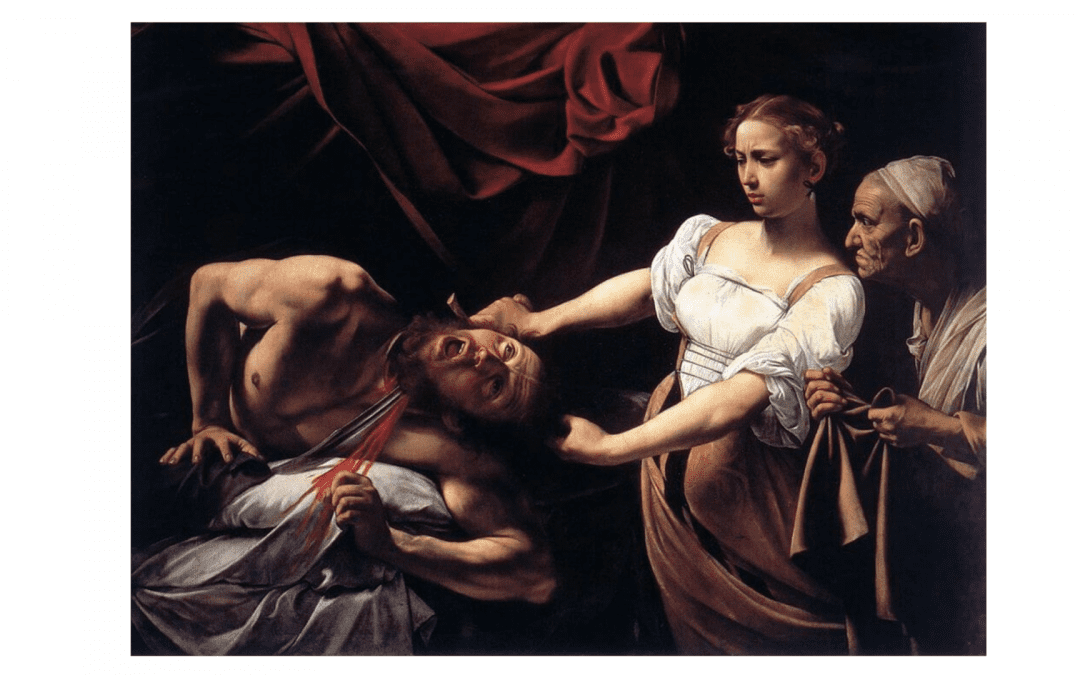I posted yesterday about visiting The Courtauld Gallery. Whilst there I bought a book: Look at this if you love great art, by Chloë Ashby. Leafing through it has reminded me how often I have featured art in the Sir Anthony Standen Adventures. I’m not sure why, I just have. I thought it might be interesting to look at the artists who were alive in Sir Anthony’s lifetime. I’ll restrict myself to great artists, using Chloë to guide me, for painters at least.
Rembrandt van Rijn was six in 1612, when the latest book, Called to Account is set. It’s due to be published on 8th November. I doubt that Sir Anthony will have come across him. Michelangelo Merisi da Caravaggio lived from 1571 to 1610. I feature his Judith Beheading Holofernes in Called to Account. Chloë Includes his Penitent Magdalene. She says that “no painting is quite as honest and direct as Caravaggio’s Penitent Magdalene,”. I needed more blood, so made my choice accordingly.
Titian lived from 1490 to 1576. Sir Anthony was around twenty-seven when Titian died. In Fire and Earth, the second book in the series, Cardinal Aldobrandini admires his uncle’s Titian, Salome with the head of John the Baptist. Oh dear, I seem to have a beheading theme. They were violent times. Chloë‘s choice is Venus Rising from the Sea.
Artemesia Gentileschi lived from 1593 to 1653 or 1656 depending on your source. The trial of her rapist is taking place when Anthony visits Aldobrandini in Called to Account. Chloë chooses her rare self portrait as Saint Catherine of Alexandria, and describes her as “one of the most progressive and expressive painters of the Italian Baroque.”
Guido Reni’s, Lot and His Daughters Leaving Sodom, is one of Chloë‘s choices. He lived in Italy from 1575 to 1642 so was productive in Anthony’s day. I haven’t mentioned him, so far. Lavinia Fontana’s Minerva Dressing is featured by Chloë who describes her as “one of the most significant women artists of the Renaissance.” She lived from 1552 to 1614, so was a contemporary of Anthony’s. I apologize for overlooking her.
Gian Lorenzo Bernini, the sculptor, lived in Italy from 1598 to 1680. Chloë chooses his Apollo and Daphne but that was sculpted between 1622 and 1625. I haven’t got there yet, and Anthony will be in his seventies by then. Pieter Bruegel the Elder’s Landscape with the Fall of Icarus eluded me. Anthony would have been two years into his spying career when Bruegel died. Anthony would have been a young boy when Lucas Cranach the Elder died. Chloë chooses his Judith with the Head of Holofernes. Holofernes’ head certainly got about.
Anthony van Dyke lived from 1599 to 1641. Chloë admires his Self-Portrait with a Sunflower. I don’t recall Sir Anthony coming across him. Sofonisba Anguissola is another contemporary female artist of Sir Anthony. I may try and include her work in a later book.
Sir Anthony would have been around fifteen when Michelangelo died. I don’t recall featuring any of his works. Diego Velázquez makes it into Chloë‘s book with Las Meninas. Sir Anthony would have been thirty when Velázquez was born. Rubens didn’t make it into Chloë‘s book, but Sir Anthony does watch him painting in the third book, The Suggested Assassin. Sir Anthony wasn’t as impressed as perhaps he should have been. Possibly he shared Chloë‘s taste.

